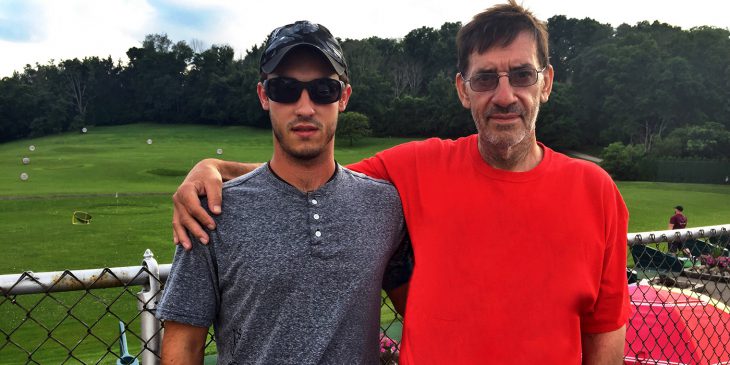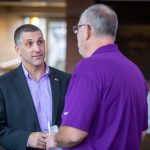For Richard Edwards, life was simple.
The 54-year-old Smithton, Pennsylvania, native has owned his own business for over 30 years. He spends a lot of time with his son, Mitchell Edwards, 22, who also owns his own business and helps his dad out from time to time.
“We’ve been close all our lives, my boy and I,” Richard Edwards said. “We’re each other’s best friends.”
But, when Richard Edwards wasn’t working or spending time with his son, he had a bottle in his hand. What started out as something to pass the time ended up an addiction.
He tried to get a handle on it, but lost control.
“All I did was work and drink. That was the routine,” he said. “I quit quite a few times. Like I said, I had all the warning signs, but by that time it was already too late.”
It was October 2016 when Richard Edwards knew something was wrong.
He went to buckle his pants when he noticed the button wouldn’t latch. His stomach protruded out, and he felt swollen and heavy. He ended up going to the hospital to find out that fluid was accumulating on the outside of his liver. It was cirrhosis.
Because of the severity of his illness, he was having fluid drained from his abdomen every two weeks, but eventually there was too much fluid retaining inside him. He ended up having to go back weekly, getting 7 to 8 liters of fluid drained each time.
“I was exhausted,” Richard Edwards said. “The way I felt getting fluid drained — I wouldn’t wish that on anyone.”
Eventually, the draining and other treatments were not enough, and as a last resort, his name was added to the liver transplant waiting list.
●●●
Mitchell Edwards knew his dad was sick from the beginning, but wondered if there was a way to help. To find the answer to that question, he turned to his computer.
“I started doing some research on being a living donor,” he said. “It was like a light at the end of the tunnel.”
Living liver donation, the process in which a healthy person donates a portion of his or her liver to someone in need of a transplant, is becoming more popular as the need for organ donors grows larger. This is all made possible because of the liver’s unique ability to regrow itself, allowing both the donor and the receiver to continue living healthy lives.
His father really didn’t like the thought of putting someone else at risk, but after mulling it over, he realized this might be his only chance.
“I told him if he didn’t want to do it, he didn’t have to,” Richard Edwards explained. “I knew there were risks associated with the procedure, and I was so worried. He was 21 and he still had his whole life in front of him.”
But at that point, his son had already made up his mind.
After consulting physicians and staff from Transplant Services at UPMC, Mitchell Edwards learned he was a genetic match, meaning he was eligible to donate.
Dr. Abhinav Humar, chief of transplantation at UPMC and clinical director of the Thomas E. Starzl Transplantation Institute, said without his son stepping up to donate, Richard Edwards could have remained on the waiting list for a long time.
“The Living Donor Liver Transplant program was a great option for Richard because it allowed him to avoid the wait time,” Humar said. “If it weren’t for Mitchell’s willingness, who knows what would’ve happened.”
- ●●●
It was June 19, 2017, the day of the operation at UPMC Montefiore.
UPMC has performed close to 20,000 transplants, including heart, lung, intestinal, kidney, liver, pancreas and multiple-organ transplants, along with heart assist device implantation, but even with the reassurance of excellent care, Mitchell Edwards was starting to get anxious.
Sitting on the medical bench preparing for the procedure, he could feel his palms begin to sweat as his heart pounded like a steady drum.
“I was so afraid of the epidural,” he said.
The next thing he knew, he woke up sitting in a hospital bed after the operation. He couldn’t remember anything from the procedure — including the epidural, which to him meant it was a great success.
“There’s always that sense of instant gratification for the surgeon,” Humar said. “Almost immediately, you can see the liver working as it goes from looking dull and having no blood to a nice, pink organ. In that moment, the healing begins.”
The healing process for the father-son duo was also quicker than expected. Mitchell Edwards went back to work within five days, and after a week, his father was released from the hospital with an opportunity for a fresh start.
“It’s a crazy feeling getting a transplant — it’s like you’re reborn,” Richard Edwards said. “I was dying before, but now it’s like every day is a new, brighter day. I’m thankful for that.”
Looking back, Mitchell Edwards was proud of what he could do for his dad.
“I’m a firm believer that anyone who can donate an organ should,” he said. “But, I don’t want any special treatment or anything like that. This was something I wanted to do for my dad.”
For more information about living donor transplant, click here.









